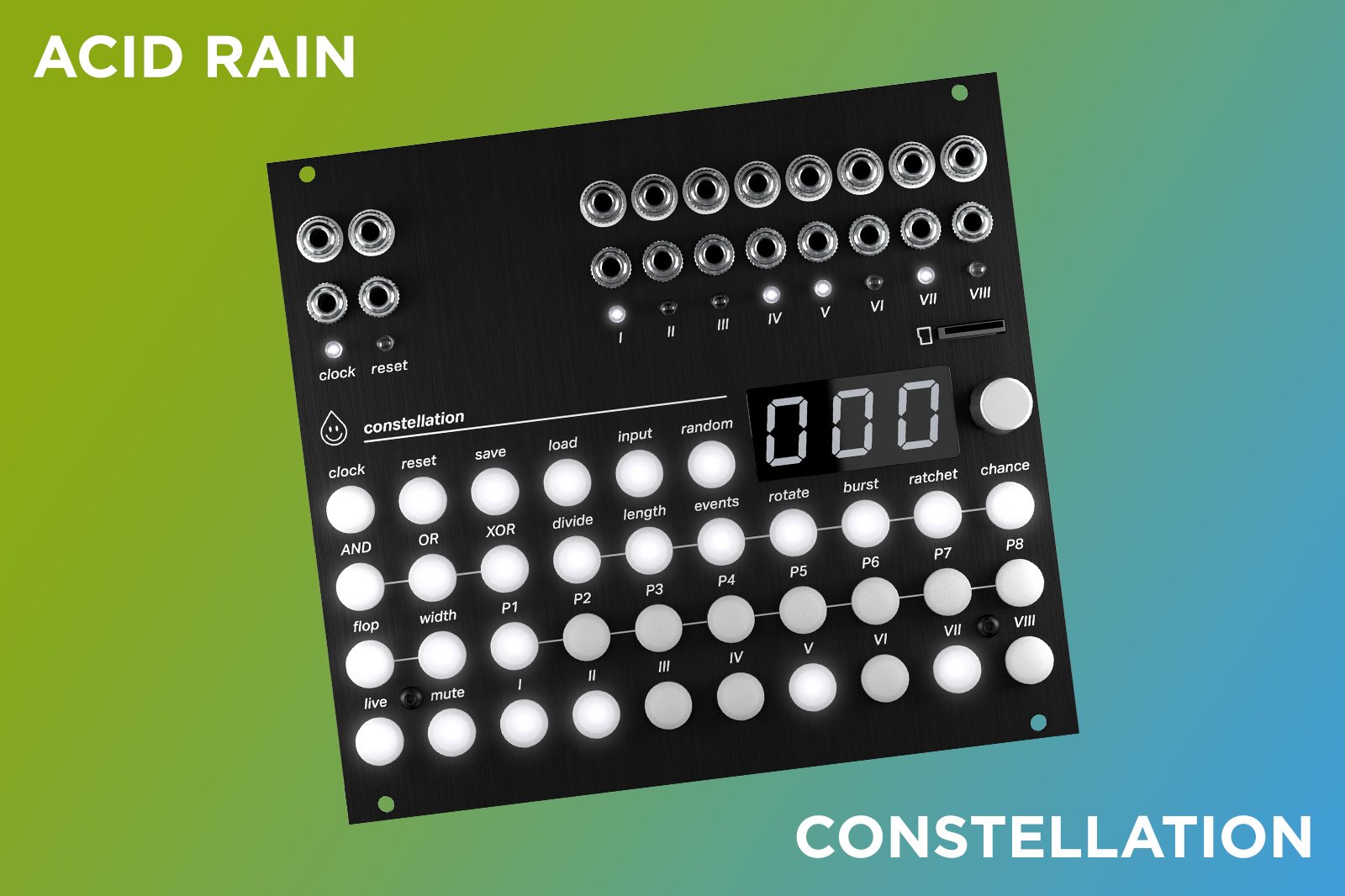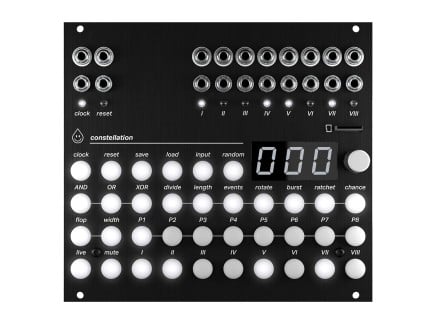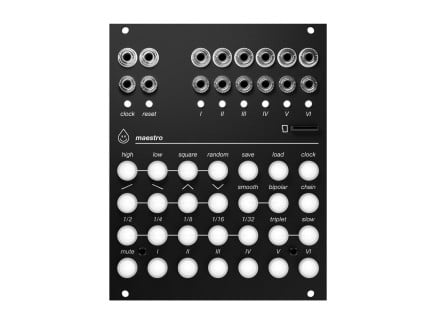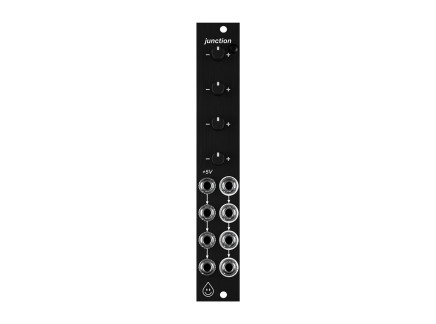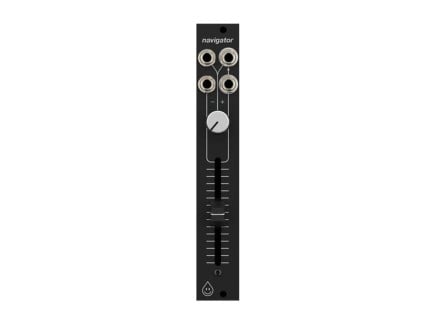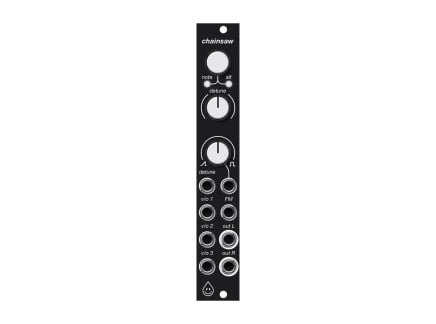Today is quite exciting, as Acid Rain Technology unveils their newest Eurorack synthesizer module—an advanced rhythm generator dubbed Constellation. And happily, we can report that it looks amazing.
Time and time again, Acid Rain Technology proves that they have their hand right on the pulse of the Eurorack modular synthesizer community—by creating modules that somehow answer the emerging needs of the artists, often even before these needs are even fully formulated. With Chainsaw, not only did Acid Rain design a powerful three-voice polyphonic oscillator, but they also managed to make it so compact that at times it is difficult to believe that all those swarms of sawtooth waves are coming from such a tiny module. With Maestro, Acid Rain embarked on an ambitious journey to develop a module that allows users to create complex modulation curves akin to automation lanes in digital audio workstations. It is that savvy approach to finding novel creative solutions in the realm of modular synthesis that makes the brand's creations turn instant hits for a wide range of artists, sound designers, and music producers.
Our experience with the brand's devices suggests that we ought to expect something different than a conventional sequencer. So let's get right to it: let's see what Constellation is all about, and why it may very well be the next thing you will want to make music with.
A Constellation of Rhythms
Before talking about what Constellation is, perhaps it is best to start with stating what it is not. Constellation is not a traditional step sequencer, and although it may serve a similar function in a patch, it radically stands out when it comes to workflow. It is a powerful and intuitive eight-channel trigger/gate generator that produces rhythmic sequences by fusing dynamically-controllable Euclidean patterns with logical operations.
Yet, Constellation is much more than just the sum of two parts. Enriched with a plethora of creative features which we will explore shortly, the module allows one to arrive at intricate, evolving rhythmic structures quite quickly and easily. So how does it work exactly?
Rhythms in Constellation are produced by eight Eucleadian pattern generators, defined by the Length and Events parameters—which respectively refer to the number of steps in a pattern and the number of pulses equally spread across each measure. Each pattern can be further spiced up via additional modifier functions like pulse probability amount, burst, and ratchet. Several patterns can be combined together via logical AND, OR, and XOR operators to expand rhythmic complexity and sprinkle in some variation. Furthermore, each channel has a dedicated control voltage input, allowing for continuous modulation of specified parameters including the length of the pattern, event density, probability amount, and signal pulse width. Oh, and of course, there is an independent clock divider/multiplier per channel, significantly expanding the module's capacity to create polyrhythms.
With all of its functions collectively, Constellation provides fruitful territory for creating all sorts of rhythms, be it tame and repetitive four on the floor or constantly evolving IDM-ish rhizomes. Running at slow speeds, it can also be perfectly adapted as a macro conductor for your patch, engaging, and disengaging events according to the rules you specify, as well as incoming modulation signals.
Constellation + Maestro: A Match Made in Modular Heaven
Upon the first look at the Constellation front panel, the resemblance to Maestro is quite obvious. Certainly, visual aesthetics is not the only thread that ties the two modules together. Both complement each other quite well functionally. While Maestro is meant to endow any patch with streams of morphing modulation signals, Constellation is there to organize distinct musical events in time as sparsely and minimally or as densely and unpredictably as the situation requires.
The two modules can share a single external clock source, or one can drive the other to stay in perfect sync. (Constellation is particularly well suited to serve as a master clock source, thanks to its front panel BPM display.) What is even more exciting, Maestro and Constellation can be patched up in stimulating cross-modulation feedback configurations. One can dedicate some outputs of Maestro to modulate specific parameters of Constellation, and visa versa: Constellation's outputs could be assigned to trigger individual channels of Maestro.
Of course, the above example doesn't suggest that the two modules necessarily have to be used together. We are dealing with a modular environment after all, and both are powerful and capable enough in their own right to be easily integrated into any sort of setup. However, it is difficult to deny that together Maestro and Constellation make up a sort of modular "power couple" that enhances and extends one another's functionality.
By the very nature of its design, the modular synthesis framework promotes the idea that there is no one way to create music, and design sounds. Experimentation is rewarding, and every new path taken leads to different possibilities. Acid Rain's Constellation clearly subscribes to this ethos by presenting its users with a significantly different approach to generating pulse patterns that guarantees to open up paths less traveled, potentially leading to places one couldn't access before. It is not necessarily an ordinary device that has something to offer to any modular enthusiast, however, it will no doubt become the heart of many setups for those who love discovering new ways to create rhythm.

